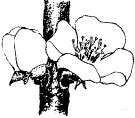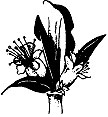Revised

Peaches, nectarines, plums, apricots
- Dormant sprays
- Prebloom or 'popcorn' sprays
- Bloom sprays
- Petal-fall sprays
- Shuck-split sprays
- First and second cover sprays
- Summer cover sprays
- Preharvest sprays
Peaches, nectarines, plums, apricots
Dormant sprays
Apply before buds swell in spring.
Mites, scale
- Material
dormant or summer oil - Comments
Oil smothers overwintering eggs of mites and scale.
Apply oil at temperatures above 40 degrees Fahrenheit and not within 14 days before or after using sulfur, or captan.
Peach leaf curl, plum pockets
A key pest
or pest complex
- Material
Bordeaux mixture
or chlorothalonil
or copper - Comments
For peach leaf curl, apply at leaf drop in late fall, and 1 to 2 additional applications in mid- to late winter before bud swell.
For plum pockets, use of resistant plum cultivars is the preferred control measure. But for susceptible cultivars, apply chlorothalonil (or Bordeaux mixture, or liquid lime-sulfur) before bud swell.
Copper for peach leaf curl only. Apply as a dormant spray in late fall during a period of dry weather.
Peaches, nectarines, plums, apricots
Prebloom or 'popcorn' sprays
 Apply when buds show white, pink or red.
Apply when buds show white, pink or red.
Plant bugs, stink bugs
- Material
carbaryl
or malathion
or esfenvalerate
or permethrin
or gamma-cyhalothrin - Comments
Plant bugs and stink bugs feed on swelling fruit and leaf buds, causing the buds to dry up. When fruit buds are damaged, blossoms may never open or may be deformed.
Use permethrin on peaches only.
Brown rot, scab, leaf spot
- Material
captan
or chlorothalonil
or myclobutanil
or sulfur - Comments
For brown rot, use chlorothalonil, captan, myclobutanil or thiophanate-methyl.
Peaches, nectarines, plums, apricots
Bloom sprays
 Apply when 25 percent of blossoms are open. Do not use insecticides during the bloom period — Save the bees.
Apply when 25 percent of blossoms are open. Do not use insecticides during the bloom period — Save the bees.
Brown rot, scab
- Material
chlorothalonil
or captan
or myclobutanil
or sulfur
or thiophanate-methyl
or propiconazole - Comments
See comments in "prebloom" section.
For propiconazole, start applications in early spring, and spray every 21 days, making no more than 4 applications.
Powdery mildew, leaf spot
- Material
myclobutanil
or sulfur
or thiophanate-methyl
or propiconazole - Comments
For powdery mildew, sulfur provides good control.
For propiconazole, start applications in early spring, and spray every 21 days, making no more than 4 applications.
Peaches, nectarines, plums, apricots
Petal-fall sprays
 Apply when most of blossom petals have fallen.
Apply when most of blossom petals have fallen.
Oriental fruit moth, plum curculio
A key pest
or pest complex
- Material
carbaryl
or malathion
or esfenvalerate
or permethrin
or spinosad
or gamma-cyhalothrin - Comments
Adult oriental fruit moth begin emerging in mid-April. First generation larva enter at a leaf axil near the tip of a shoot and bores down the central core for several inches, causing the terminal to wilt or "flag."
Surface feeding by overwintering adult plum curculio can scar or misshape the fruit by harvest, while feeding by the larvae causes premature fruit drop.
Use permethrin on peaches only.
Spinosad for oriental fruit moth only.
Plant bugs, stink bugs
A key pest
or pest complex
- Material
carbaryl
or malathion
or esfenvalerate
or permethrin
or gamma-cyhalothrin - Comments
Feeding on small fruit by plant bugs and stink bugs causes the fruit to fall or become scarred and malformed (cat-facing) as they grow. Populations of plant bugs are worst where weed control is poorest. Keep weeds mowed regularly.
Use permethrin on peaches only.
Coryneium blight
- Material
chlorothalonil - Comments
Apply 1 to 2 weeks after petal fall or at shuck-split.
Brown rot, scab
- Material
chlorothalonil
or captan
or myclobutanil
or sulfur
or thiophanate-methyl
or propiconazole - Comments
Make one additional application for scab at shuck-split.
Peaches, nectarines, plums, apricots
Shuck-split sprays
 Apply about 10 days after petal-fall spray.
Apply about 10 days after petal-fall spray.
Brown rot, scab
- Material
captan
or myclobutanil
or sulfur
or thiophanate-methyl - Comments
Observe intervals between last application and harvest.
Mites
- Material
summer oil
or insecticidal soap
or pyrethrins and rotenone - Comments
To prevent damage to foliage or fruits, never use a summer oil with captan, carbaryl, or other sulfur-containing pesticides. Allow at least 14 days between applications of sulfur-containing compounds and the use of a summer oil. Apply oil at temperatures above 40 degrees Fahrenheit and below 90 degrees Fahrenheit.
For insecticidal soap repeat application 3 to 4 days later.
For pyrethrin and rotenone premix, repeat application every 5 to 10 days or as needed, do not apply within 1 day of harvest.
Plum curculio oriental fruit moth
A key pest
or pest complex
- Material
esfenvalerate
or malathion
or carbaryl
or permethrin
or spinosad
or gamma-cyhalothrin - Comments
See comments in "petal-fall sprays" section.
Spinosad for oriental fruit moth only.
Plant bugs, stink bugs
A key pest
or pest complex
- Material
carbaryl
or malathion
or esfenvalerate
or permethrin - Comments
See comments in "petal-fall sprays" section.
Powdery mildew
- Material
myclobutanil
or sulfur
or thiophanate-methyl
Peaches, nectarines, plums, apricots
First and second cover sprays
Apply 10 days after shuck-split and again 10 days later.
Plum curculio, oriental fruit moth
A key pest
or pest complex
- Material
carbaryl
or malathion
or esfenvalerate
or permethrin
or spinosad
or gamma-cyhalothrin - Comments
See comments in "petal-fall sprays" section.
Spinosad for oriental fruit moth only.
Plant bugs, stink bugs
A key pest
or pest complex
- Material
carbaryl
or malathion
or esfenvalerate
or spinosad
or gamma-cyhalothrin - Comments
See comments in "petal-fall sprays" section.
Mites
- Material
summer oil
or insecticidal soap
or pyrethrins and rotenone - Comments
See comments in "shuck-split" section.
Lesser peachtree borer
- Material
carbaryl
or esfenvalerate
or permethrin - Comments
or spinosad
or gamma-cyhalothrin - Comments
Adult moths typically begin to emerge in mid-May (mid-Missouri); apply weekly sprays during moth flight (through June). Larvae can become established only in damaged tissue (pruning wounds, cankered areas, sun-scalded bark, etc.). Once established, the larvae feed on growing bark and may enlarge the damaged area, often girdling the limb
Direct sprays from ground level up the trunk and including the main scaffold limbs, wetting the bark thoroughly.
Brown rot, scab
- Material
captan
or myclobutanil
or sulfur
or thiophanate-methyl
Peaches, nectarines, plums, apricots
Summer cover sprays
Apply at 10- to 14-day intervals.
Oriental fruit moth
A key pest
or pest complex
- Material
carbaryl
or malathion
or esfenvalerate
or permethrin
or spinosad
or gamma-cyhalothrin - Comments
Later-generation oriental fruit moth larvae may enter the fruit near the stem end and make feeding burrows that often extend to the pit.
Mites
- Material
summer oil
or insecticidal soap
or pyrethrins and rotenone - Comments
See comments in "shuck-split" section.
Powdery mildew
- Material
sulfur
or propiconazole - Days between last application and harvest
Table 2
Aphids
- Material
malathion
or insecticidal soap
or neem
or pyrethrins and rotenone
Brown rot
- Material
captan
or myclobutanil
or sulfur
or thiophanate-methyl - Days between last application and harvest
Table 2
Peaches, nectarines, plums, apricots
Preharvest sprays
Apply 1 to 2 weeks before harvest.
Green June beetle. Japanese beetle
- Material
carbaryl
or malathion
or neem
or pyrethrins and rotenone
or gamma-cyhalothrin - Comments
Adult green June beetles and Japanese beetles can feed on both green and ripening fruit. - Days between last application and harvest
Table 2
Spotted wing drosophila
- Material
spinosad - Comments
Insecticide treatment should begin when fruit first begins to color and continue through harvest. For more on SWD, see Lincoln University Cooperative Extension publication Monitoring for Spotted Wing Drosophila (PDF). - Days between last application and harvest
Table 2
Oriental fruit moth
- Material
carbaryl
or malathion
or esfenvalerate
or permethrin
or spinosad - Comments
Adult flights of oriental fruit moth may occur at this time. - Days between last application and harvest
Table 2
Aphids
- Material
carbaryl
or insecticidal soap
or neem
or pyrethrins and rotenone - Comments
See comments in "summer cover sprays" section. - Days between last application and harvest
Table 2